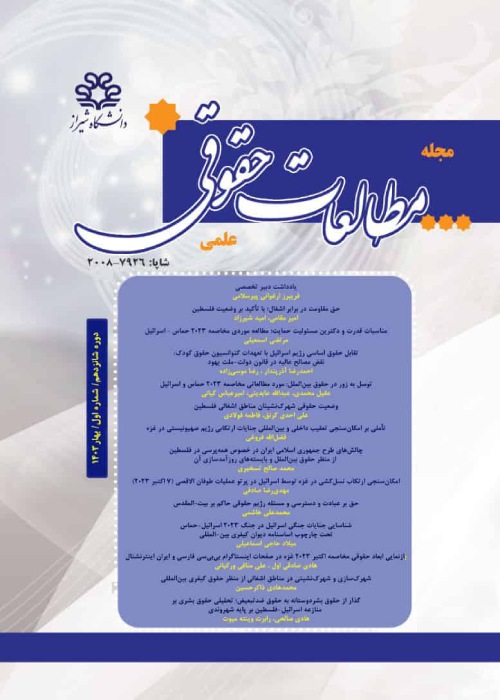Examination of the Last Clear Chance Doctrine in Iranian Law in Comparison with Common Law and Jurisprudential Systems
The concept of the last clear chance doctrine, rooted in common law, originally emerged as a refinement of the joint fault theory. Its objective was to adapt and modify the joint fault theory within the context of causation relationships based on proximate cause. This modification involved distinguishing between real causes and non-real causes, identifying the effective cause based on a standard, and isolating the legal causes from the real ones through the application of the proximate cause rule. This, in turn, paved the way for identifying the responsible cause by employing either the principle of common fault or the principle of last clear chance to prevent loss. The last clear chance doctrine comes into play when an individual creates a perilous situation, both legally and causally, but finds themselves unable to extricate themselves from the resulting danger or remains oblivious to it. In such circumstances, another person, who possesses knowledge of the impending danger along with the capability to avert it, seizes the opportunity to prevent the loss. Failure to utilize this chance to prevent harm results in the imposition of full compensation respo nsibility upon this second individual. The emergence of the low-cost theory in the latter half of the 20th century significantly influenced the last clear chance doctrine. This economic approach emphasized that, among the factors contributing to accidents and losses, if both the victim and the party responsible for the loss can prevent such losses through precautionary measures, the entity that could have averted the loss at the lowest cost, but failed to do so, would assume the liability for damages or compensation. This economic perspective added a fresh dimension to the doctrine, aligning it with principles of economic deterrence. Within the jurisprudential framework, when victim and wrongdoer errors are characterized by a shared cause and agency (regardless of whether the victim is the agent or the cause), applying either the proximate cause rule or the last clear chance rule yields comparable outcomes. If the agent incurs loss, the rule of action grants them the last opportunity to prevent that loss, which they fail to exploit. Conversely, if the agent is the cause, they are held accountable due to their possession of the last chance to avert the loss in temporal terms. However, complications arise when the errors of the victim and the wrongdoer assume an indirect cause relationship without agency (managerial responsibility). The application of the first cause rule diverges from the last clear chance rule in jurisprudence. In numerous instances, the last opportunity to prevent loss is held by the delayed cause rather than the primary cause. In situations where victim and wrongdoer are simultaneously affected in a steward-like capacity, without temporal priority or delay, identifying the last clear chance is unfeasible. In such scenarios, the rule of joint fault dictates that both parties share equal compensation responsibility due to their simultaneous contributory roles in the accident. However, the determination of the degree of each party's fault impact in causing the accident and damages remains unexplored within the jurisprudential system, leaving room for further contemplation. In Iranian law, analogous to the jurisprudential system, the application of the last clear chance rule serves as the final sieve through which real and legal causes sift to identify the responsible cause. The stewardship of the victim in circumstances allowing loss avoidance, despite the existence of a real cause and legal cause, absolves the responsible cause. The rationale is that attributing loss to the responsible party necessitates assigning some or all of the loss to an entity other than the victim. The victim, having had the final opportunity to prevent the loss and having chosen not to, bears the loss personally. Notably, a discrepancy between the theory of the first cause and the last clear chance doctrine arises within the community of indirect causes, wherein the former theory imposes responsibility on the second cause despite awareness of the influence of the first cause and the potential for avoidance. Article 536 of the Islamic Civil Code underscores the legislator's inclination toward a delayed cause perspective and a deviation from the antecedent cause theory, in favor of the last clear chance criterion for loss avoidance.
- حق عضویت دریافتی صرف حمایت از نشریات عضو و نگهداری، تکمیل و توسعه مگیران میشود.
- پرداخت حق اشتراک و دانلود مقالات اجازه بازنشر آن در سایر رسانههای چاپی و دیجیتال را به کاربر نمیدهد.



